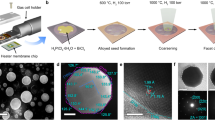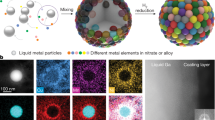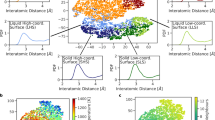Abstract
Nanomaterials with high-index facets have desirable properties but are often challenging to synthesize. One way to realize such structures is by incorporating guest metal or metalloid atoms that can stabilize high-index facets by influencing surface energies. However, the effect of different guest atoms can vary substantially, and the vast parameter set (possible combinations of host nanoparticles and guest species) makes a trial-and-error experimental approach to explore every combination impractical. Here we report a data-driven approach incorporating high-throughput density functional theory calculations to assess surface energies of low- and high-index facets of nanoparticles (9 transition metals) with surfaces modified by 13 guest atoms. Machine-learning techniques are then used to understand the critical features leading to energetically favoured high-index facet formation in the context of tetrahexahedron. The predictions are validated by chemical synthesis, demonstrating the efficacy of this approach in accelerating the synthesis of tetrahexahedron materials with exposed {210} facets.

This is a preview of subscription content, access via your institution
Access options
Subscribe to this journal
Receive 12 digital issues and online access to articles
118,99 € per year
only 9,92 € per issue
Buy this article
- Purchase on SpringerLink
- Instant access to full article PDF
Prices may be subject to local taxes which are calculated during checkout





Similar content being viewed by others
Data availability
The data supporting the findings of the study are available in the paper and its Supplementary Information. Source data are provided with this paper. All DFT calculation data are published in the OQMD (https://oqmd.org).
Code availability
The code used in this work is deposited in Github (https://github.com/dohunkang/HTDFT_THH).
References
Xiao, C. et al. High-index-facet- and high-surface-energy nanocrystals of metals and metal oxides as highly efficient catalysts. Joule 4, 2562–2598 (2020).
Tian, N. et al. Synthesis of tetrahexahedral platinum nanocrystals with high-index facets and high electro-oxidation activity. Science 316, 732–735 (2007).
Choi, C. et al. Highly active and stable stepped Cu surface for enhanced electrochemical CO2 reduction to C2H4. Nat. Catal. 3, 804–812 (2020).
Hong, J. W. et al. Hexoctahedral Au nanocrystals with high-index facets and their optical and surface-enhanced Raman scattering properties. J. Am. Chem. Soc. 134, 4565–4568 (2012).
Popczun, E. J. et al. Nanostructured nickel phosphide as an electrocatalyst for the hydrogen evolution reaction. J. Am. Chem. Soc. 135, 9267–9270 (2013).
Butterfield, A. G. et al. Morphology-dependent phase selectivity of cobalt sulfide during nanoparticle cation exchange reactions. J. Am. Chem. Soc. 143, 7915–7919 (2021).
Halford, G. C. & Personick, M. L. Bridging colloidal and electrochemical nanoparticle growth with in situ electrochemical measurements. Acc. Chem. Res. 56, 1228–1238 (2023).
Shi, Y. et al. Noble-metal nanocrystals with controlled shapes for catalytic and electrocatalytic applications. Chem. Rev. 121, 649–735 (2021).
Ghosh, S. & Manna, L. The many “facets” of halide ions in the chemistry of colloidal inorganic nanocrystals. Chem. Rev. 118, 7804–7864 (2018).
Personick, M. L. & Mirkin, C. A. Making sense of the mayhem behind shape control in the synthesis of gold nanoparticles. J. Am. Chem. Soc. 135, 18238–18247 (2013).
Shen, B. et al. Morphology engineering in multicomponent hollow metal chalcogenide nanoparticles. ACS Nano 17, 4642–4649 (2023).
Huang, L. et al. Regioselective deposition of metals on seeds within a polymer matrix. J. Am. Chem. Soc. 144, 4792–4798 (2022).
McDarby, S. P. et al. An integrated electrochemistry approach to the design and synthesis of polyhedral noble metal nanoparticles. J. Am. Chem. Soc. 142, 21322–21335 (2020).
Xiao, J. et al. Synthesis of convex hexoctahedral Pt micro/nanocrystals with high-index facets and electrochemistry-mediated shape evolution. J. Am. Chem. Soc. 135, 18754–18757 (2013).
Xia, Y., Xia, X. & Peng, H. C. Shape-controlled synthesis of colloidal metal nanocrystals: thermodynamic versus kinetic products. J. Am. Chem. Soc. 137, 7947–7966 (2015).
Barmparis, G. D. et al. Nanoparticle shapes by using Wulff constructions and first-principles calculations. Beilstein J. Nanotechnol. 6, 361–368 (2015).
Barnard, A. S., Lin, X. M. & Curtiss, L. A. Equilibrium morphology of face-centered cubic gold nanoparticles >3 nm and the shape changes induced by temperature. J. Phys. Chem. B 109, 24465–24472 (2005).
Huang, L. et al. Shape regulation of high-index facet nanoparticles by dealloying. Science 365, 1159–1163 (2019).
Ji, L. et al. Shape reconstruction from commercial Pt/C to high-index Pt/C for advanced electrocatalysts. ACS Catal. 13, 13846–13855 (2023).
Huang, L. et al. High-index-facet metal-alloy nanoparticles as fuel cell electrocatalysts. Adv. Mater. 32, e2002849 (2020).
Huang, L. et al. Multimetallic high-index faceted heterostructured nanoparticles. J. Am. Chem. Soc. 142, 4570–4575 (2020).
Shen, B. et al. Crystal structure engineering in multimetallic high-index facet nanocatalysts. Proc. Natl Acad. Sci. USA 118, e2105722118 (2021).
Emery, A. A. et al. High-throughput computational screening of perovskites for thermochemical water splitting applications. Chem. Mater. 28, 5621–5634 (2016).
Aykol, M. et al. High-throughput computational design of cathode coatings for Li-ion batteries. Nat. Commun. 7, 13779 (2016).
Nandy, A. et al. Computational discovery of transition-metal complexes: from high-throughput screening to machine learning. Chem. Rev. 121, 9927–10000 (2021).
Yin, K. et al. An automated predictor for identifying transition states in solids. NPJ Comput. Mater. 6, 16 (2020).
Westermayr, J. et al. High-throughput property-driven generative design of functional organic molecules. Nat. Comput. Sci. 3, 139–148 (2023).
Jun, K. et al. Lithium superionic conductors with corner-sharing frameworks. Nat. Mater. 21, 924–931 (2022).
Xu, Y. et al. High-throughput calculations of magnetic topological materials. Nature 586, 702–707 (2020).
Hautier, G. Finding the needle in the haystack: materials discovery and design through computational ab initio high-throughput screening. Comput. Mater. Sci. 163, 108–116 (2019).
Curtarolo, S. et al. The high-throughput highway to computational materials design. Nat. Mater. 12, 191–201 (2013).
Zhu, Q. et al. Automated synthesis of oxygen-producing catalysts from Martian meteorites by a robotic AI chemist. Nat. Synth. 3, 319–328 (2023).
Garnero, C. et al. Single-crystalline body centered FeCo nano-octopods: from one-pot chemical growth to a complex 3D magnetic configuration. Nano Lett. 21, 3664–3670 (2021).
Boukouvala, C., Daniel, J. & Ringe, E. Approaches to modelling the shape of nanocrystals. Nano Converg. 8, 26 (2021).
Zhang, S. et al. Monodisperse AgPd alloy nanoparticles and their superior catalysis for the dehydrogenation of formic acid. Angew. Chem. Int. Ed. 52, 3681–3684 (2013).
Yin, Z. et al. Hybrid catalyst coupling single-atom Ni and nanoscale Cu for efficient CO2 electroreduction to ethylene. J. Am. Chem. Soc. 144, 20931–20938 (2022).
Yang, Y. et al. Operando studies reveal active Cu nanograins for CO2 electroreduction. Nature 614, 262–269 (2023).
Kim, D. et al. Synergistic geometric and electronic effects for electrochemical reduction of carbon dioxide using gold–copper bimetallic nanoparticles. Nat. Commun. 5, 4948 (2014).
Hitt, J. L. et al. A high throughput optical method for studying compositional effects in electrocatalysts for CO2 reduction. Nat. Commun. 12, 1114 (2021).
Hitt, J. L. et al. High-throughput fluorescent screening and machine learning for feature selection of electrocatalysts for the alkaline hydrogen oxidation reaction. ACS Sustain. Chem. Eng. 10, 16299–16312 (2022).
Smith, P. T. et al. Molecular thin films enable the synthesis and screening of nanoparticle megalibraries containing millions of catalysts. J. Am. Chem. Soc. 145, 14031–14043 (2023).
Ha, M. et al. Multicomponent plasmonic nanoparticles: from heterostructured nanoparticles to colloidal composite nanostructures. Chem. Rev. 119, 12208–12278 (2019).
Lee, S. et al. Heterogeneous component Au (outer)–Pt (middle)–Au (inner) nanorings: synthesis and vibrational characterization on middle Pt nanorings with surface-enhanced raman scattering. ACS Nano 16, 11259–11267 (2022).
Koo, K. et al. Formation mechanism of high-index faceted Pt–Bi alloy nanoparticles by evaporation-induced growth from metal salts. Nat. Commun. 14, 3790 (2023).
Ward, L. et al. A general-purpose machine learning framework for predicting properties of inorganic materials. NPJ Comput. Mater. 2, 16028 (2016).
Xia, Y. et al. A unified understanding of minimum lattice thermal conductivity. Proc. Natl Acad. Sci. USA 120, e2302541120 (2023).
Lundberg, S. M. et al. From local explanations to global understanding with explainable AI for trees. Nat. Mach. Intell. 2, 56–67 (2020).
Loevlie, D. J., Ferreira, B. & Mpourmpakis, G. Demystifying the chemical ordering of multimetallic nanoparticles. Acc. Chem. Res. 56, 248–257 (2023).
Yao, Y. et al. High-entropy nanoparticles: synthesis–structure–property relationships and data-driven discovery. Science 376, eabn3103 (2022).
Denton, A. R. & Ashcroft, N. W. Vegard’s law. Phys. Rev. A 43, 3161–3164 (1991).
Hohenberg, P. & Kohn, W. Inhomogeneous electron gas. Phys. Rev. B 136, 864–871 (1964).
Kohn, W. & Sham, L. J. Self-consistent equations including exchange and correlation effects. Phys. Rev. A 140, 1133–1138 (1965).
Kresse, G. & Furthmüller, J. Efficient iterative schemes for ab initio total-energy calculations using a plane-wave basis set. Phys. Rev. B 54, 11169–11186 (1996).
Kresse, G. & Furthmüller, J. Efficiency of ab-initio total energy calculations for metals and semiconductors using a plane-wave basis set. Comput. Mater. Sci. 6, 15–50 (1996).
Blochl, P. E. Projector augmented-wave method. Phys. Rev. B 50, 17953–17979 (1994).
Perdew, J. P., Burke, K. & Ernzerhof, M. Generalized gradient approximation made simple. Phys. Rev. Lett. 77, 3865–3868 (1996).
Kresse, G. & Joubert, D. From ultrasoft pseudopotentials to the projector augmented-wave method. Phys. Rev. B 59, 1758–1775 (1999).
Saal, J. E. et al. Materials design and discovery with high-throughput density functional theory: the Open Quantum Materials Database (OQMD). JOM 65, 1501–1509 (2013).
Kirklin, S. et al. The Open Quantum Materials Database (OQMD): assessing the accuracy of DFT formation energies. NPJ Comput. Mater. 1, 15010 (2015).
Acknowledgements
We thank T. Sengupta (Northwestern University) for professional editorial advice. Research was sponsored by the Army Research Office under grants W911NF-23-1-0141 and W911NF-23-1-0285, the Toyota Research Institute, Inc., and the Sherman Fairchild Foundation, Inc. D.K. acknowledges funding from the International Institute for Nanotechnology. Z.Y. and D.K. acknowledge partial support from the Predictive Science and Engineering Design (PSED) programme at Northwestern University. J.S. acknowledges support from the MRSEC programme (DMR-1720139) at the Materials Research Center of Northwestern University. This work made use of the EPIC and BioCryo facilities of Northwestern University’s NUANCE Center, which has received support from the SHyNE Resource (NSF ECCS-2025633), the International Institute for Nanotechnology and Northwestern’s MRSEC programme (NSF DMR-1720139). We acknowledge the computational resources provided by the Quest high-performance computing facility at Northwestern University.
Author information
Authors and Affiliations
Contributions
C.A.M. and C.M.W. supervised the research. Z.Y. and B.S. performed materials synthesis, characterization and analysis. D.K. performed HF-DFT calculation and machine learning. J.S., J.H., Z.W. and L.H. participated in discussions and provided suggestions. All authors contributed to the writing.
Corresponding authors
Ethics declarations
Competing interests
The authors declare no competing interests.
Peer review
Peer review information
Nature Synthesis thanks Rao Huang, Tung-Han Yang and the other, anonymous, reviewer(s) for their contribution to the peer review of this work. Primary Handling Editor: Alison Stoddart, in collaboration with the Nature Synthesis team.
Additional information
Publisher’s note Springer Nature remains neutral with regard to jurisdictional claims in published maps and institutional affiliations.
Supplementary information
Supplementary Information
Supplementary Figs. 1–26, Notes 1 and 2, Tables 1–4 and references 1–13.
Source data
Source Data Fig. 1
Source data for Fig. 1a,b.
Source Data Fig. 2
Source data for Fig. 2c.
Rights and permissions
Springer Nature or its licensor (e.g. a society or other partner) holds exclusive rights to this article under a publishing agreement with the author(s) or other rightsholder(s); author self-archiving of the accepted manuscript version of this article is solely governed by the terms of such publishing agreement and applicable law.
About this article
Cite this article
Ye, Z., Shen, B., Kang, D. et al. A data-driven approach for the guided regulation of exposed facets in nanoparticles. Nat. Synth 3, 922–929 (2024). https://doi.org/10.1038/s44160-024-00561-1
Received:
Accepted:
Published:
Issue Date:
DOI: https://doi.org/10.1038/s44160-024-00561-1
This article is cited by
-
Data-driven discovery of biaxially strained single atoms array for hydrogen production
Nature Communications (2025)



